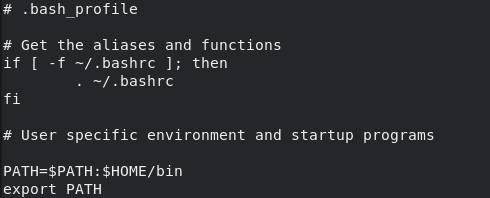Linux Interface & Getting help from Manual Pages
 Afridi Shaik
Afridi ShaikTable of contents

Linux Shell Interface
Root User:-
[root@localhost ~]#
root -----> root/admin user
localhost---> Serverhostname [/etc/hostname]
~ --------> Home Directory
# --------> Root/Super user prompt
Normal User:-
[user@localhost ~]$
user -----> username
localhost---> Server Hostname [/etc/hostname]
~ --------> Home Directory
$ -------> Normal User
Ever Thought about How this interface is configured and how can we customize it? Let me take you to a more detailed way
root -----> /root/.bash_profile & /root/.bashrc
user -----> /home/[user]/.bash_profile & /root/.bashrc

bash_profile
if condition checks bashrc file exists or not if it exists it will get sourced
PATH=$PATH:$HOME/bin
This will help us to load binaries based on user. So the user can execute the commands it store in PATH variable
- Export the PATH variable
bash_rc
In bash_rc we mostly declare the PS1 Variable. For better user interfaces
- Below PS1 Value declares the interface in my server scenario
\u -----> username
\h -----> hotname
\w ----> working directory
$ ----> Depends on User If it's root it will show '#' if it's non-root user it will show '$'
- You can use lot of Customization For example, while using rm command you can make alias in bashrc file It
alias rm='rm -i'
Note:- This bash_profile & bashrc comes from /etc/skel directory
Command Syntax:-
The syntax of a command generally follows the pattern:
command [options] <arguments>
Command: The actual command you want to execute.
Options: Flags or switches that modify the behavior of the command. Options are preceded by a hyphen (
-) or a double hyphen (--).Arguments: The input or data on which the command operates. Arguments are typically filenames, directories, or other parameters required by the command.
1.
cd- Change DirectoryThe
cdcommand is used to change the current working directory.cd /path/to/directoryIn this example,
/path/to/directoryis the argument, specifying the destination directory.To access the manual page
cd, you can use:man cd
df Command
This command will display disk space usage for all mounted filesystems in a human-readable format by using options, and it will include a column indicating the filesystem type.
-h: Display sizes in a human-readable format (e.g., KB, MB, GB).-T: Display the filesystem type.-P: Output in the POSIX format, which is useful for scriptingdf -hTP
To access the manual page df , you can use:
man df
To navigate to a specific section in the manual page, you can use the man command followed by the manual page name and the section number. The syntax is as follows:
man [section_number] command
For example, if you want to see the section of the manual page specifically related to the ls command, you can use:
man 1 ls
Here, 1 is the section number for user commands. Similarly, you can access different sections by changing the section number:
1: User commands2: System calls3: Library functions, covering functions provided by the C library4: Device files and drivers5: File formats and conventions6: Games and screensavers7: Miscellaneous (including macro packages and conventions)8: System administration commands and daemons
Whatis :-
The whatis command in Linux is used to display a one-line description of a command. The information is sourced from the manual pages (man pages) on the system. The whatis command is useful for quickly getting an overview of a command's purpose without having to read the entire manual page.
syntax:-
whatis command
Example 1: Basic Usage
whatis ls
This command will provide a short description of the ls command, which is used to list directory contents.
Example 2: Multiple Commands
whatis ls cp mv
You can specify multiple commands in a single whatis command. In this example, it will display short descriptions for the ls, cp, and mv commands.
Example 3: Regular Expressions
whatis '^c'
You can use regular expressions with whatis to match commands. In this example, it will display short descriptions for commands starting with the letter 'c'.
Example 4: Case-Insensitive Search
whatis -i tar
The -i option makes the search case insensitive. This example will display short descriptions for the tar command, regardless of the case.
Note:- If we get any error while using man / whatis for specific command use below command to update the db of manual
mandb
The --help option is used for providing a quick overview of the usage and available options of a command. It is a useful way to get a brief summary of the command's functionality without having to consult the full manual page.
Let's take the lsblk command as an example:
lsblk --help
Running this command will display a summary of the lsblk command's usage and options. Here's a simplified example of what you might see:
Usage: lsblk [OPTION]... [DEVICE]...
List information about all available or the specified block devices.
Mandatory arguments to long options are mandatory for short options too.
-a, --all print all devices
-b, --bytes print SIZE in bytes rather than in human readable format
-f, --fs output info about filesystems
-h, --help display this help and exit
-l, --list use list layout (default)
-o, --output list define columns to display
-p, --pairs use key="value" output format (default)
-P, --paths print full device path
-r, --raw use raw output format
-t, --tree use tree layout
-x, --exclude list exclude devices
-d, --nodeps don't print dependent devices
-S, --scsi use SCSI output format
-I, --include list include only devices
-i, --invert invert sort order
-T, --topology use topology output format
-s, --output-separator string print output separator
-k, --kbytes print SIZE in kilobytes
-K, --kibibytes print SIZE in kibibytes
-m, --units SIZE print SIZE in units of SIZE
-w, --wait wait for devices to settle before exiting
-y, --sync invoke sync before getting info
In this example, you can see a list of available options with a brief description for each. The --help option is a quick reference for users who want to understand the basic functionality of a command and its available options without delving into the detailed manual page (man lsblk).
Subscribe to my newsletter
Read articles from Afridi Shaik directly inside your inbox. Subscribe to the newsletter, and don't miss out.
Written by



